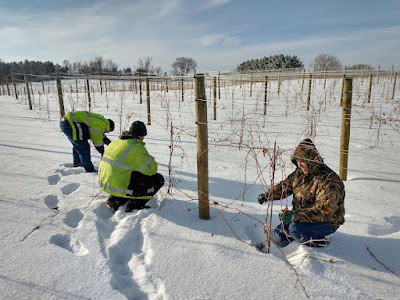 |
| A vineyard with grow tubes on newly planted vines. Photo: A. Klodd. |
Author: Annie Klodd, Extension Educator - Fruit and Vegetable Production. kloddann@umn.edu
To appreciate why it's so important to remove grow tubes in the fall, we first have to understand the original function of grow tubes.
Grow tubes cause daily, exaggerated temperature fluctuations
 |
| Grow tubes should be removed well before winter to expose vines to normal winter temperatures. Photo: A. Klodd |
Grow tubes delay the "cold acclimation" process in the fall
Viticulturists and nurseries recommend removing grow tubes as soon as possible in the late summer/early fall rather than waiting until the start of winter. The vines need to experience the natural autumn environment in order to acclimate for winter.
Perennial plants, including grapevines, respond to cooling temperatures in the late summer and fall as a signal to start acclimating for winter. They start to push carbohydrates and nutrients down to the roots, which the vines need the following spring. Simultaneously, the grapevine buds and canes also "harden off," meaning they turn brown and woody and develop an ability to withstand harsh winter temperatures (Source).
If a young green shoot is inside a grow tube throughout the fall, the temperatures around the shoot remain artificially high and the vine may not have a chance to fully acclimate for winter. It will be more susceptible to winter injury.
For these reasons, viticulturists generally recommend removing grow tubes before the early fall. Some say August, others say September. The main idea is to remove them as soon as they have completed their function and well before the first frost.
Do you need grow tubes at all?
It depends.
Unless I am assisting an organic grape grower who does not plan to apply herbicides, I typically do recommend grow tubes for new vines in the planting year. This is only to enable safe herbicide application.
 |
| Strong herbicide-based weed control made possible by the use of grow tubes to protect the new vines. Photo: A. Klodd |
Grow tubes enable herbicides to be sprayed around the tender young vines without damaging them. Weed competition drastically slows vine establishment and delays revenue, so managing weeds is economically critical in the first year.
If you are confident in your ability to control weeds without making contact between the herbicides and the newly planted vines, then you might avoid using grow tubes. This can sometimes be achieved by spot-spraying and using a shielded sprayer. However, some herbicides and nozzle types are particularly susceptible to drift, making this genuinely tricky. If you are a first-time farmer without solid herbicide sprayer expertise, I do not recommend risking it.
In terms of promoting vine growth, research by Zabadal and Dittmer (1998) found that there is no season long advantage to grow tubes for that purpose. While the vines in this study grew taller with grow tubes in the first 67 days, they had less leaf area and the same height as non-tubed vines by the end of the season (Source).
One more thing: The Japanese Beetles
It is difficult to impossible to spray for Japanese beetles that get inside of grow tubes. If this becomes a problem in your vineyard, it underscores the importance of removing the grow tubes as soon as they are done serving their function.
Key Points:
- Grow tubes were designed to trap heat and accelerate plant growth. During the winter, this affect can damage the vines.
- Remove grow tubes as soon as possible in the late summer/early fall to allow time for cold acclimation
- Make your grow tubes worth it by practicing good weed control while the vines are protected
- Scout for Japanese beetles - if there is significant feeding inside the tubes, consider removing them
Sources:
https://www.tandfonline.com/
https://extension.umd.edu/resource/grow-tubes-grapevines-drawbacks

Comments
Post a Comment